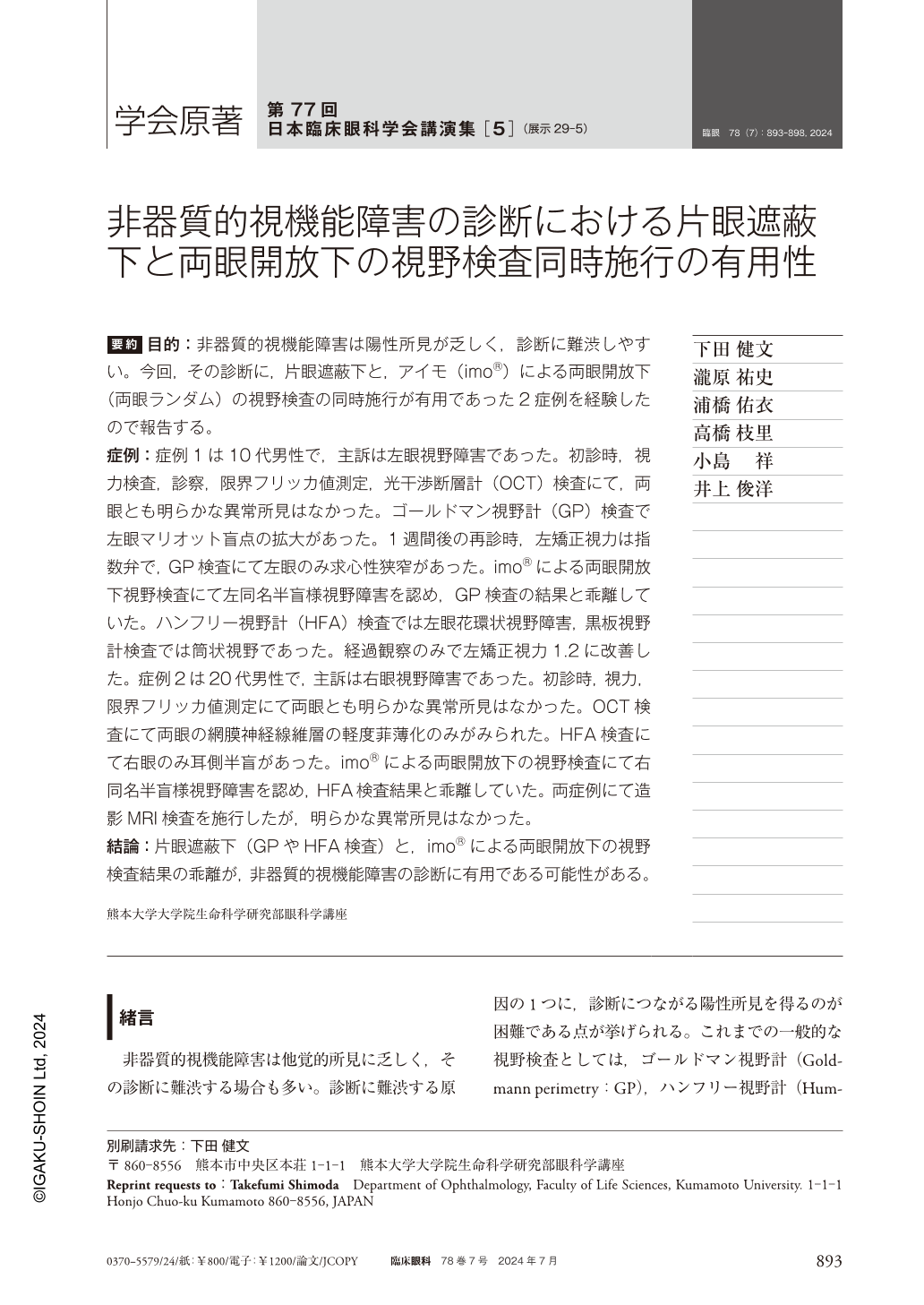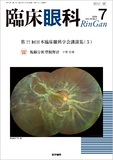Japanese
English
- 有料閲覧
- Abstract 文献概要
- 1ページ目 Look Inside
- 参考文献 Reference
要約 目的:非器質的視機能障害は陽性所見が乏しく,診断に難渋しやすい。今回,その診断に,片眼遮蔽下と,アイモ(imo®)による両眼開放下(両眼ランダム)の視野検査の同時施行が有用であった2症例を経験したので報告する。
症例:症例1は10代男性で,主訴は左眼視野障害であった。初診時,視力検査,診察,限界フリッカ値測定,光干渉断層計(OCT)検査にて,両眼とも明らかな異常所見はなかった。ゴールドマン視野計(GP)検査で左眼マリオット盲点の拡大があった。1週間後の再診時,左矯正視力は指数弁で,GP検査にて左眼のみ求心性狭窄があった。imo®による両眼開放下視野検査にて左同名半盲様視野障害を認め,GP検査の結果と乖離していた。ハンフリー視野計(HFA)検査では左眼花環状視野障害,黒板視野計検査では筒状視野であった。経過観察のみで左矯正視力1.2に改善した。症例2は20代男性で,主訴は右眼視野障害であった。初診時,視力,限界フリッカ値測定にて両眼とも明らかな異常所見はなかった。OCT検査にて両眼の網膜神経線維層の軽度菲薄化のみがみられた。HFA検査にて右眼のみ耳側半盲があった。imo®による両眼開放下の視野検査にて右同名半盲様視野障害を認め,HFA検査結果と乖離していた。両症例にて造影MRI検査を施行したが,明らかな異常所見はなかった。
結論:片眼遮蔽下(GPやHFA検査)と,imo®による両眼開放下の視野検査結果の乖離が,非器質的視機能障害の診断に有用である可能性がある。
Abstract Purpose:Non-organic visual loss often lacks specific findings, making its diagnosis difficult. Here we report two cases in which use of the monocular and binocular visual field tests with imo®(binocular random mode)was useful for diagnosing non-organic visual loss.
Cases:Case 1 was a teenage boy with a left visual field defect. In the patient's first visit to Kumamoto University Hospital, the visual acuity test, physical examination, critical flicker frequency measurement, and optical coherence tomography(OCT)showed no apparent abnormalities in either eye. The Goldmann perimetry(GP)test suggested an enlarged Mariotte blind spot in the left eye. Five days after the first visit, the best-corrected visual acuity(BCVA)in the left eye decreased to counting fingers, and the GP test showed concentric restriction in the left eye only. The binocular visual field test with imo® revealed a left homonymous hemianopia-like visual field defect, which diverged from the GP test results. Seven days after the first visit, the Humphrey field analyzer(HFA)test showed the cloverleaf-like defect pattern and a tunnel visual field in the left eye. The patient's BCVA in the left eye later improved to 1.2 without medical treatment. Case 2 was a man in his twenties with a right visual field defect. The examination performed at Kumamoto University Hospital showed no apparent abnormalities in either eye on the visual acuity test or critical flicker frequency measurement. The OCT test revealed bilateral mild thinning of the retinal nerve fiber layer. The HFA test indicated temporal hemianopia in the right eye only. The binocular visual field test with imo® showed a right homonymous hemianopia-like visual field defect, which diverged from the HFA test results. Magnetic resonance imaging conducted in both cases showed no apparent abnormalities.
Conclusion:The discrepancy between the results of the monocular visual field test using GP or HFA and those of the binocular visual field test using imo® may be useful diagnosing of non-organic visual loss.

Copyright © 2024, Igaku-Shoin Ltd. All rights reserved.


